From Wikipedia, the free encyclopedia
 This processed color image of Jupiter was produced in 1990 by the U.S. Geological Survey from a Voyager image captured in 1979. The colors have been enhanced to bring out detail. | |||||||||||||||||||||||
| Orbital characteristics[1][2] | |||||||||||||||||||||||
|---|---|---|---|---|---|---|---|---|---|---|---|---|---|---|---|---|---|---|---|---|---|---|---|
| Epoch J2000 | |||||||||||||||||||||||
| Aphelion | 816,520,751 km 5.45810410 AU | ||||||||||||||||||||||
| Perihelion: | 740,573,646 km 4.95042906 AU | ||||||||||||||||||||||
| Semi-major axis: | 778,547,199 km 5.20426658 AU | ||||||||||||||||||||||
| Eccentricity: | 0.048774888 | ||||||||||||||||||||||
| Orbital period: | 4,334.50 days 11.862615 yr[3] | ||||||||||||||||||||||
| Synodic period: | 398.88 days[4] | ||||||||||||||||||||||
| Avg. orbital speed: | 13.07 km/s[4] | ||||||||||||||||||||||
| Mean anomaly: | 18.818473° | ||||||||||||||||||||||
| Inclination: | 1.304626° 6.09° to Sun's equator | ||||||||||||||||||||||
| Longitude of ascending node: | 100.491580° | ||||||||||||||||||||||
| Argument of perihelion: | 275.066051° | ||||||||||||||||||||||
| Satellites: | 63 | ||||||||||||||||||||||
| Physical characteristics | |||||||||||||||||||||||
| Equatorial radius: | 71,492 ± 4 km[5][6] 11.209 Earths | ||||||||||||||||||||||
| Polar radius: | 66,854 ± 10 km[5][6] 10.517 Earths | ||||||||||||||||||||||
| Flattening: | 0.06487 ± 0.00015 | ||||||||||||||||||||||
| Surface area: | 6.21796×1010 km²[7][6] 121.9 Earths | ||||||||||||||||||||||
| Volume: | 1.43128×1015 km³[4][6] 1321.3 Earths | ||||||||||||||||||||||
| Mass: | 1.8986×1027 kg[4] 317.8 Earths | ||||||||||||||||||||||
| Mean density: | 1.326 g/cm³[4][6] | ||||||||||||||||||||||
| Equatorial surface gravity: | 24.79 m/s²[4][6] 2.358 g | ||||||||||||||||||||||
| Escape velocity: | 59.5 km/s [4][6] | ||||||||||||||||||||||
| Sidereal rotation period: | 9.925 h[8] | ||||||||||||||||||||||
| Rotation velocity at equator: | 12.6 km/s 45,300 km/h | ||||||||||||||||||||||
| Axial tilt: | 3.13°[4] | ||||||||||||||||||||||
| Right ascension of North pole: | 268.057° 17 h 52 min 14 s[5] | ||||||||||||||||||||||
| Declination of North pole: | 64.496°[5] | ||||||||||||||||||||||
| Albedo: | 0.343 (bond) 0.52 (geom.)[4] | ||||||||||||||||||||||
| Surface temp.: 1 bar level 0.1 bar |
| ||||||||||||||||||||||
| Apparent magnitude: | -1.6 to -2.94 [4] | ||||||||||||||||||||||
| Angular size: | 29.8" — 50.1" [4] | ||||||||||||||||||||||
| Adjectives: | Jovian | ||||||||||||||||||||||
| Atmosphere [4] | |||||||||||||||||||||||
| Surface pressure: | 20–200 kPa[9] (cloud layer) | ||||||||||||||||||||||
| Scale height: | 27 km | ||||||||||||||||||||||
| Composition: |
| ||||||||||||||||||||||
Jupiter (pronounced /ˈdʒuːpɨtɚ/) is the fifth planet from the Sun and the largest planet within the solar system. It is two and a half times as massive as all of the other planets in our solar system combined. Jupiter, along with Saturn, Uranus and Neptune, is classified as a gas giant. Together, these four planets are sometimes referred to as the Jovian planets, where Jovian is the adjectival form of Jupiter.
The planet was known by astronomers of ancient times and was associated with the mythology and religious beliefs of many cultures. The Romans named the planet after the Roman god Jupiter (also called Jove).[10] When viewed from Earth, Jupiter can reach an apparent magnitude of −2.8, making it the third brightest object in the night sky after the moon and Venus. (However, at certain points in its orbit, Mars can briefly exceed Jupiter's brightness.)
The planet Jupiter is primarily composed of hydrogen with a small proportion of helium; it may also have a rocky core of heavier elements. Because of its rapid rotation the planet is an oblate spheroid (it possesses a slight but noticeable bulge around the equator). The outer atmosphere is visibly segregated into several bands at different latitudes, resulting in turbulence and storms along their interacting boundaries. A prominent result is the Great Red Spot, a giant storm that is known to have existed since at least the seventeenth century. Surrounding the planet is a faint planetary ring system and a powerful magnetosphere. There are also at least 63 moons, including the four large moons called the Galilean moons that were first discovered by Galileo Galilei in 1610. Ganymede, the largest of these moons, has a diameter greater than that of the planet Mercury.
Jupiter has been explored on several occasions by robotic spacecrafts, most notably during the early Pioneer and Voyager fly-by missions and later by the Galileo orbiter. The latest probe to visit Jupiter was the Pluto-bound New Horizons spacecraft in late February 2007. The probe used the gravity from Jupiter to increase its speed and adjust its trajectory toward Pluto, thereby saving years of travel. Future targets for exploration include the possible ice-covered liquid ocean on the Jovian moon Europa.
Contents[hide] |
[edit] Structure
Jupiter is one of the four gas giants; that is, it is not primarily composed of solid matter. It is the largest planet in the Solar System, having a diameter of 142,984 km at its equator. Jupiter's density, 1.326 g/cm³, is the second highest of the gas giant planets, but lower than any of the four terrestrial planets. (Of the gas giants, Neptune has the highest density.)
[edit] Composition
Jupiter's upper atmosphere is composed of about 90% hydrogen and 10% helium by number of atoms,[4] or 86% H2 and 13% He by fraction of gas molecules—see table to the right. Since a helium atom has about four times as much mass as a hydrogen atom, the composition changes when described in terms of the proportion of mass contributed by different atoms. Thus the atmosphere is approximately 75% hydrogen and 24% helium by mass, with the remaining 1% of the mass consisting of other elements. The interior contains denser materials such that the distribution is roughly 71% hydrogen, 24% helium and 5% other elements by mass. The atmosphere contains trace amounts of methane, water vapor, ammonia, and silicon-based compounds. There are also traces of carbon, ethane, hydrogen sulphide, neon, oxygen, phosphine, and sulfur. The outermost layer of the atmosphere contains crystals of frozen ammonia.[11][12] Through infrared and ultraviolet measurements, trace amounts of benzene and other hydrocarbons have also been found.[13]
The atmospheric proportions of hydrogen and helium are very close to the theoretical composition of the primordial solar nebula. However, neon in the upper atmosphere only consists of 20 parts per million by mass, which is about a tenth as abundant as in the Sun.[14] Helium is also depleted, although to a lesser degree. This depletion may be a result of precipitation of these elements into the interior of the planet.[15] Abundances of heavier inert gases in Jupiter's atmosphere are about two to three times that of the sun.
Based on spectroscopy, Saturn is thought to be similar in composition to Jupiter, but the other gas giants Uranus and Neptune have relatively much less hydrogen and helium.[16] However, because of the lack of atmospheric entry probes, high quality abundance numbers of the heavier elements are lacking for the outer planets beyond Jupiter.
[edit] Mass

Jupiter is 2.5 times more massive than all the other planets in our solar system combined; so massive that its barycenter with the Sun actually lies above the Sun's surface (1.068 solar radii from the Sun's center). Although this planet dwarfs the Earth (with a diameter 11 times as great) it is considerably less dense. Jupiter's volume is equal to 1,317 Earths, yet is only 318 times as massive.[17][18]
Theoretical models indicate that if Jupiter had much more mass than it does at present, the planet would shrink. For small changes in mass, the radius would not change appreciably, and above about four Jupiter masses the interior would become so much more compressed under the increased gravitation force that the planet's volume would actually decrease despite the increasing amount of matter. As a result, Jupiter is thought to have about as large a diameter as a planet of its composition and evolutionary history can achieve. The process of further shrinkage with increasing mass would continue until appreciable stellar ignition is achieved in high-mass brown dwarfs around 50 Jupiter masses.[19] This has led some astronomers to term it a "failed star", although it is unclear whether or not the processes involved in the formation of planets like Jupiter are similar to the processes involved in the formation of multiple star systems.
Although Jupiter would need to be about seventy-five times as massive to fuse hydrogen and become a star, the smallest red dwarf is only about 30% larger in radius than Jupiter.[20][21] In spite of this, Jupiter still radiates more heat than it receives from the Sun. The amount of heat produced inside the planet is nearly equal to the total solar radiation it receives.[22] This additional heat radiation is generated by the Kelvin-Helmholtz mechanism through adiabatic contraction. This process results in the planet shrinking by about 2 cm each year.[23] When it was first formed, Jupiter was much hotter and was about twice its current diameter.[24]
[edit] Internal structure
Jupiter is thought to consist of a dense core with a mixture of elements, a surrounding layer of liquid metallic hydrogen with some helium, and an outer layer predominantly of molecular hydrogen[23]. Beyond this basic outline, there is still considerable uncertainty. The core is often described as rocky, but its detailed composition is unknown, as are the properties of materials at the temperatures and pressures of those depths (see below). The existence of the core is suggested by gravitational measurements[23] indicating a mass of from 12 to 45 times the Earth's mass or roughly 3%-15% of the total mass of Jupiter.[25][22] The presence of the core is also suggested by models of planetary formation involving initial formation of a rocky or icy core that is massive enough to collect its bulk of hydrogen and helium from the protosolar nebula. The core may in fact be absent, as gravitational measurements aren't precise enough to rule that possibility out entirely. Assuming it does exist, it may also be shrinking, as convection currents of hot liquid metallic hydrogen mix with the molten core and carry its contents to higher levels in the planetary interior[23].
The core region is surrounded by dense metallic hydrogen, which extends outward to about 78% of the radius of the planet.[22] Rain-like droplets of helium and neon precipitate downward through this layer, depleting the abundance of these elements in the upper atmosphere.[15][26]
Above the layer of metallic hydrogen lies a transparent interior atmosphere of liquid hydrogen and gaseous hydrogen, with the gaseous portion extending downward from the cloud layer to a depth of about 1,000 km.[22] Instead of a clear boundary or surface between these different phases of hydrogen, there is probably a smooth gradation from gas to liquid as one descends.[27][28] This smooth transition happens whenever the temperature is above the critical temperature, which for hydrogen is only 33 K (see hydrogen).
The temperature and pressure inside Jupiter increase steadily toward the core. At the phase transition region where liquid hydrogen (heated beyond its critical point) becomes metallic, it is believed the temperature is 10,000 K and the pressure is 200 GPa. The temperature at the core boundary is estimated to be 36,000 K and the interior pressure is roughly 3,000–4,500 GPa.[22]
[edit] Cloud layers
- See also: Cloud pattern on Jupiter
Jupiter is perpetually covered with clouds composed of ammonia crystals and possibly ammonium hydrosulfide. The clouds are located in the tropopause and are arranged into bands of different latitudes, known as tropical regions. These are sub-divided into lighter-hued zones and darker belts. The interactions of these conflicting circulation patterns cause storms and turbulence. Wind speeds of 100 m/s (360 km/h) are common in zonal jets.[29] The zones have been observed to vary in width, color and intensity from year to year, but they have remained sufficiently stable for astronomers to give them identifying designations.[18]
The cloud layer is only about 50 km deep, and consists of at least two decks of clouds: a thick lower deck and a thin clearer region. There may also be a thin layer of water clouds underlying the ammonia layer, as evidenced by flashes of lightning detected in the atmosphere of Jupiter. (Water is a polar molecule that can carry a charge, so it is capable of creating the charge separation needed to produce lightning.)[22] These electrical discharges can be up to a thousand times as powerful as lightning on the Earth.[30] The water clouds can form thunderstorms driven by the heat rising from the interior.[31]
The orange and brown coloration in the clouds of Jupiter are caused by upwelling compounds that change color when they are exposed to ultraviolet light from the Sun. The exact makeup remains uncertain, but the substances are believed to be phosphorus, sulfur or possibly hydrocarbons.[32][22] These colorful compounds, known as chromophores, mix with the warmer, lower deck of clouds. The zones are formed when rising convection cells form crystallizing ammonia that masks out these lower clouds from view.[17]
Jupiter's low axial tilt means that the poles constantly receive less solar radiation than at the planet's equatorial region. Convection within the interior of the planet transports more energy to the poles, however, balancing out the temperatures at the cloud layer.[18]
[edit] Great Red Spot and other storms

The best known feature of Jupiter is the Great Red Spot, a persistent anticyclonic storm located 22° south of the equator that is larger than Earth. It is known to have been in existence since at least 1831,[33] and possibly since 1665.[34] Mathematical models suggest that the storm is stable and may be a permanent feature of the planet.[35] The storm is large enough to be visible through Earth-based telescopes.
The oval object rotates counterclockwise, with a period of about 6 days.[36] The Great Red Spot's dimensions are 24–40,000 km × 12–14,000 km. It is large enough to contain two or three planets of Earth's diameter.[37] The maximum altitude of this storm is about 8 km above the surrounding cloudtops.[38]
Storms such as this are common within the turbulent atmospheres of gas giants. Jupiter also has white ovals and brown ovals, which are lesser unnamed storms. White ovals tend to consist of relatively cool clouds within the upper atmosphere. Brown ovals are warmer and located within the "normal cloud layer". Such storms can last for hours or centuries.

Even before Voyager proved that the feature was a storm, there was strong evidence that the spot could not be associated with any deeper feature on the planet's surface, as the Spot rotates differentially with respect to the rest of the atmosphere, sometimes faster and sometimes more slowly. During its recorded history it has traveled several times around the planet relative to any possible fixed rotational marker below it.
In 2000, an atmospheric feature formed in the southern hemisphere that is similar in appearance to the Great Red Spot, but smaller in size. This was created when several smaller, white oval-shaped storms merged to form a single feature—these three smaller white ovals were first observed in 1938. The merged feature was named Oval BA, and has been nicknamed Red Spot Junior. It has since increased in intensity and changed color from white to red.[39][40][41]
[edit] Planetary rings
Jupiter has a faint planetary ring system composed of three main segments: an inner torus of particles known as the halo, a relatively bright main ring, and an outer "gossamer" ring.[42] These rings appear to be made of dust, rather than ice as is the case for Saturn's rings.[22] The main ring is probably made of material ejected from the satellites Adrastea and Metis. Material that would normally fall back to the moon is pulled into Jupiter because of its strong gravitational pull. The orbit of the material veers towards Jupiter and new material is added by additional impacts.[43] In a similar way, the moons Thebe and Amalthea probably produce the two distinct components of the gossamer ring.[43]
[edit] Magnetosphere
Jupiter's broad magnetic field is 14 times as strong as the Earth's, ranging from 4.2 gauss (0.42 mT) at the equator to 10–14 gauss (1.0–1.4 mT) at the poles, making it the strongest in the solar system (with the exception of sunspots).[17] This field is believed to be generated by eddy currents—swirling movements of conducting materials—within the metallic hydrogen core. The field traps a sheet of ionized particles from the solar wind, generating a highly-energetic magnetic field outside the planet—the magnetosphere. Electrons from this plasma sheet ionize the torus-shaped cloud of sulfur dioxide generated by the tectonic activity on the moon Io. Hydrogen particles from Jupiter's atmosphere are also trapped in the magnetosphere. Electrons within the magnetosphere generate a strong radio signature that produces bursts in the range of 0.6–30 MHz.[44]
At about 75 Jupiter radii from the planet, the interaction of the magnetosphere with the solar wind generates a bow shock. Surrounding Jupiter's magnetosphere is a magnetopause, located at the inner edge of a magnetosheath, where the planet's magnetic field becomes weak and disorganized. The solar wind interacts with these regions, elongating the magnetosphere on Jupiter's lee side and extending it outward until it nearly reaches the orbit of Saturn. The four largest moons of Jupiter all orbit within the magnetosphere, which protects them from the solar wind.[22]

The magnetosphere of Jupiter is responsible for intense episodes of radio emission from the planet's polar regions. Volcanic activity on the Jovian moon Io (see below) injects gas into Jupiter's magnetosphere, producing a torus of particles about the planet. As Io moves through this torus, the interaction generates Alfven waves that carry ionized matter into the polar regions of Jupiter. As a result, radio waves are generated through a cyclotron maser mechanism, and the energy is transmitted out along a cone-shaped surface. When the Earth intersects this cone, the radio emissions from Jupiter can exceed the solar radio output.[45]
[edit] Orbit and rotation
The average distance between Jupiter and the Sun is 778 million km (about 5.2 times the average distance from the Earth to the Sun, or 5.2 AU) and it completes an orbit every 11.86 years. The elliptical orbit of Jupiter is inclined 1.31° compared to the Earth. Because of an eccentricity of 0.048, the distance from Jupiter and the Sun varies by 75 million km between perihelion and aphelion, or the nearest and most distant points of the planet along the orbital path respectively.
The axial tilt of Jupiter is relatively small: only 3.13°. As a result this planet does not experience significant seasonal changes, in contrast to Earth and Mars for example.[46]
Jupiter's rotation is the solar system's fastest, completing a rotation on its axis in slightly less than ten hours; this creates an equatorial bulge easily seen through an Earth-based amateur telescope. This rotation requires a centripetal acceleration at the equator of about 1.67 m/s², compared to the equatorial surface gravity of 24.79 m/s²; thus the net acceleration felt at the equatorial surface is only about 23.12 m/s². The planet is shaped as an oblate spheroid, meaning that the diameter across its equator is longer than the diameter measured between its poles. On Jupiter, the equatorial diameter is 9275 km longer than the diameter measured through the poles.[28]
Because Jupiter is not a solid body, its upper atmosphere undergoes differential rotation. The rotation of Jupiter's polar atmosphere is about 5 minutes longer than that of the equatorial atmosphere; three "systems" are used as frames of reference, particularly when graphing the motion of atmospheric features. System I applies from the latitudes 10° N to 10° S; its period is the planet's shortest, at 9h 50m 30.0s. System II applies at all latitudes north and south of these; its period is 9h 55m 40.6s. System III was first defined by radio astronomers, and corresponds to the rotation of the planet's magnetosphere; its period is Jupiter's "official" rotation.[47]
[edit] Observation
Jupiter is usually the fourth brightest object in the sky (after the Sun, the Moon and Venus);[17] however at times Mars appears brighter than Jupiter. Depending on Jupiter's position with respect to the Earth, it can vary in visual magnitude from as bright as −2.8 at opposition down to −1.6 during conjunction with the Sun. The angular diameter of Jupiter likewise varies from 50.1 to 29.8 arc seconds.[4] Jupiter will have a favorable opposition in September of 2010.[citation needed]
Earth overtakes Jupiter every 398.9 days as it orbits the Sun, a duration called the synodic period. As it does so, Jupiter appears to undergo retrograde motion with respect to the background stars. That is, for a period of time Jupiter seems to move backward in the night sky, performing a looping motion.
Jupiter's 12-year orbital period corresponds to the dozen constellations in the zodiac.[18] As a result, each time Jupiter reaches opposition it has advanced eastward by about the width of a zodiac constellation. The orbital period of Jupiter is also about two-fifths the orbital period of Saturn, forming a 5:2 orbital resonance between the two largest planets in the Solar System.
Because the orbit of Jupiter is outside the Earth's, the phase angle of Jupiter as viewed from the Earth never exceeds 11.5°, and is almost always close to zero. That is, the planet always appears nearly fully illuminated when viewed through Earth-based telescopes. It was only during spacecraft missions to Jupiter that crescent views of the planet were obtained.[48]
[edit] Research and exploration
[edit] Ground-based telescope research
In 1610, Galileo Galilei discovered the four largest moons of Jupiter, Io, Europa, Ganymede and Callisto (now known as the Galilean moons) using a telescope; thought to be the first observation of moons other than Earth's. Note, however, that Chinese historian of astronomy, Xi Zezong, has claimed that Gan De, a Chinese astronomer, made this discovery of one of Jupiter's moons in 362 BC with the unaided eye, nearly 2 millennia earlier.[49][50] Galileo's was also the first discovery of a celestial motion not apparently centered on the Earth. It was a major point in favor of Copernicus' heliocentric theory of the motions of the planets; Galileo's outspoken support of the Copernican theory placed him under the threat of the Inquisition.[51]
During 1660s, Cassini used a new telescope to discover spots and colorful bands on Jupiter and observed that the planet appeared oblate; that is, flattened at the poles. He was also able to estimate the rotation period of the planet.[12] In 1690 Cassini noticed that the atmosphere undergoes differential rotation.[22]

The Great Red Spot, a prominent oval-shaped feature in the southern hemisphere of Jupiter, may have been observed as early as 1664 by Robert Hooke and in 1665 by Giovanni Cassini, although this is disputed. The pharmacist Heinrich Schwabe produced the earliest known drawing to show details of the Great Red Spot in 1831.[52]
The Red Spot was reportedly lost from sight on several occasions between 1665 and 1708 before becoming quite conspicuous in 1878. It was recorded as fading again in 1883 and at the start of the twentieth century.[53]
Both Giovanni Borelli and Cassini made careful tables of the motions of the Jovian moons, allowing predictions of the times when the moons would pass before or behind the planet. By the 1670s, however, it was observed that when Jupiter was on the opposite side of the Sun from the Earth, these events would occur about 17 minutes later than expected. Ole Rømer deduced that sight is not instantaneous (a finding that Cassini had earlier rejected[12]), and this timing discrepancy was used to estimate the speed of light.[54]
In 1892, E. E. Barnard observed a fifth satellite of Jupiter with the 36-inch refractor at Lick Observatory in California. The discovery of this relatively small object, a testament to his keen eyesight, quickly made him famous. The moon was later named Amalthea.[55] It was the last planetary moon to be discovered directly by visual observation.[56] An additional eight satellites were subsequently discovered prior to the fly-by of the Voyager 1 probe in 1979.
In 1932, Rupert Wildt identified absorption bands of ammonia and methane in the spectra of Jupiter.[57]
Three long-lived anticyclonic features termed white ovals were observed in 1938. For several decades they remained as separate features in the atmosphere, sometimes approaching each other but never merging. Finally, two of the ovals merged in 1998, then absorbed the third in 2000, becoming Oval BA.[58]
In 1955, Bernard Burke and Kenneth Franklin detected bursts of radio signals coming from Jupiter at 22.2 MHz.[22] The period of these bursts matched the rotation of the planet, and they were also able to use this information to refine the rotation rate. Radio bursts from Jupiter were found to come in two forms: long bursts (or L-bursts) lasting up to several seconds, and short bursts (or S-bursts) that had a duration of less than a hundredth of a second.[59]
Scientists discovered that there were three forms of radio signals being transmitted from Jupiter.
- Decametric radio bursts (with a wavelength of tens of meters) vary with the rotation of Jupiter, and are influenced by interaction of Io with Jupiter's magnetic field.[60]
- Decimetric radio emission (with wavelengths measured in centimeters) was first observed by Frank Drake and Hein Hvatum in 1959.[22] The origin of this signal was from a torus-shaped belt around Jupiter's equator. This signal is caused by cyclotron radiation from electrons that are accelerated in Jupiter's magnetic field.[61]
- Thermal radiation is produced by heat in the atmosphere of Jupiter.[22]
During the period July 16, 1994 to July 22, 1994, over twenty fragments from the comet Shoemaker-Levy 9 hit Jupiter's southern hemisphere, providing the first direct observation of a collision between two solar system objects. This impact provided useful data on the composition of Jupiter's atmosphere.[62][63]
[edit] Exploration with space probes
Since 1973 a number of automated spacecraft have visited Jupiter. Flights to other planets within the Solar System are accomplished at a cost in energy, which is described by the net change in velocity of the spacecraft, or delta-v. Reaching Jupiter from Earth requires a delta-v of 9.2 km/s,[64] which is comparable to the 9.7 km/s delta-v needed to reach low Earth orbit.[65] Fortunately, gravity assists through planetary flybys can be used to reduce the energy required to reach Jupiter, albeit at the cost of a significantly longer flight duration.[64]
[edit] Fly-by missions
| Spacecraft | Closest approach | Distance |
|---|---|---|
| Pioneer 10 | December 3, 1973 | 130,000 km |
| Pioneer 11 | December 4, 1974 | 34,000 km |
| Voyager 1 | March 5, 1979 | 349,000 km |
| Voyager 2 | July 9, 1979 | 570,000 km |
| Ulysses | February 1992 | 409,000 km |
| February 2004 | 240,000,000 km | |
| Cassini | December 30, 2000 | 10,000,000 km |
| New Horizons | February 28, 2007 | 2,304,535 km |
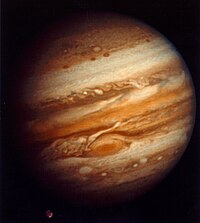
Beginning in 1973, several spacecraft have performed planetary fly-by maneuvers that brought them within observation range of Jupiter. The Pioneer missions obtained the first close-up images of Jupiter's atmosphere and several of its moons. They discovered that the radiation fields in the vicinity of the planet were much stronger than expected, but both spacecraft managed to survive in that environment. The trajectories of these spacecraft were used to refine the mass estimates of the Jovian system. Occultations of the radio signals by the planet resulted in better measurements of Jupiter's diameter and the amount of polar flattening.[18][66]
Six years later, the Voyager missions vastly improved the understanding of the Galilean moons and discovered Jupiter's rings. They also confirmed that the Great Red Spot was anticyclonic. Comparison of images showed that the Red Spot had changed hue since the Pioneer missions, turning from orange to dark brown. A torus of ionized atoms was discovered along Io's orbital path, and volcanoes were found on the moon's surface, some in the process of erupting. As the spacecraft passed behind the planet, it observed flashes of lightning in the night side atmosphere.[18][11]
The next mission to encounter Jupiter, the Ulysses solar probe, performed a fly-by maneuver in order to attain a polar orbit around the Sun. During this pass the spacecraft conducted studies on Jupiter's magnetosphere. However, since Ulysses has no cameras, no images were taken. A second fly-by six years later was at a much greater distance.[67]
In 2000, the Cassini probe, en route to Saturn, flew by Jupiter and provided some of the highest-resolution images ever made of the planet. On December 19, 2000, the spacecraft captured an image of the moon Himalia, but the resolution was too low to show surface details.[68]
The New Horizons probe, en route to Pluto, flew by Jupiter for gravity assist. Closest approach was on February 28, 2007.[69] The probe's cameras measured plasma output from volcanoes on Io and studied all four Galilean moons in detail, as well as making long-distance observations of the outer moons Himalia and Elara.[70] Imaging of the Jovian system began September 4, 2006.[71][72]
[edit] Galileo mission

So far the only spacecraft to orbit Jupiter is the Galileo orbiter, which went into orbit around Jupiter on December 7, 1995. It orbited the planet for over seven years, conducting multiple flybys of all of the Galilean moons and Amalthea. The spacecraft also witnessed the impact of Comet Shoemaker-Levy 9 as it approached Jupiter in 1994, giving a unique vantage point for the event. However, while the information gained about the Jovian system from Galileo was extensive, its originally-designed capacity was limited by the failed deployment of its high-gain radio transmitting antenna.[73]
An atmospheric probe was released from the spacecraft in July 1995, entering the planet's atmosphere on December 7. It parachuted through 150 km of the atmosphere, collecting data for 57.6 minutes, before being crushed by the pressure to which it was subjected by that time (about 22 times Earth normal, at a temperature of 153 °C).[74] It would have melted thereafter, and possibly vaporized. The Galileo orbiter itself experienced a more rapid version of the same fate when it was deliberately steered into the planet on September 21, 2003 at a speed of over 50 km/s, in order to avoid any possibility of it crashing into and possibly contaminating Europa—a moon which has been hypothesized to have the possibility of harboring life.[73]
[edit] Future probes
NASA is planning a mission to study Jupiter in detail from a polar orbit. Named Juno, the spacecraft is planned to launch by 2011.[75]
Because of the possibility of a liquid ocean on Jupiter's moon Europa, there has been great interest in studying the icy moons in detail. A mission proposed by NASA was dedicated to doing so. The JIMO (Jupiter Icy Moons Orbiter) was expected to be launched sometime after 2012. However, the mission was deemed too ambitious and its funding was cancelled.[76]
[edit] Moons
Jupiter has at least 63 natural satellites. Of these, 47 are less than 10 kilometres in diameter and have only been discovered since 1975. The four largest moons, known as the "Galilean moons", are Io, Europa, Ganymede and Callisto.

[edit] Galilean moons
The orbits of Io, Europa, and Ganymede, some of the largest satellites in the solar system, form a pattern known as a Laplace resonance; for every four orbits that Io makes around Jupiter, Europa makes exactly two orbits and Ganymede makes exactly one. This resonance causes the gravitational effects of the three large moons to distort their orbits into elliptical shapes, since each moon receives an extra tug from its neighbors at the same point in every orbit it makes. The tidal force from Jupiter, on the other hand, works to circularize their orbits.[77]
The eccentricity of their orbits causes regular flexing of the three moons' shapes, with Jupiter's gravity stretching them out as they approach it and allowing them to spring back to more spherical shapes as they swing away. This tidal flexing heats the moons' interiors via friction. This is seen most dramatically in the extraordinary volcanic activity of innermost Io (which is subject to the strongest tidal forces), and to a lesser degree in the geological youth of Europa's surface (indicating recent resurfacing of the moon's exterior).
| The Galilean moons, compared to Earth's Moon | |||||||||
|---|---|---|---|---|---|---|---|---|---|
| Name | Diameter | Mass | Orbital radius | Orbital period | |||||
| km | % | kg | % | km | % | days | % | ||
| Io | eye'-oe ˈaɪəʊ | 3643 | 105 | 8.9×1022 | 120 | 421,700 | 110 | 1.77 | 7 |
| Europa | ew-roe'-pə jʊˈrəʊpə | 3122 | 90 | 4.8×1022 | 65 | 671,034 | 175 | 3.55 | 13 |
| Ganymede | gan'-ə-meed ˈgænəmid | 5262 | 150 | 14.8×1022 | 200 | 1,070,412 | 280 | 7.15 | 26 |
| Callisto | kə-lis'-toe kəˈlɪstəʊ | 4821 | 140 | 10.8×1022 | 150 | 1,882,709 | 490 | 16.69 | 61 |
[edit] Classification of moons
Before the discoveries of the Voyager missions, Jupiter's moons were arranged neatly into four groups of four, based on commonality of their orbital elements. Since then, the large number of new small outer moons has complicated this picture. There are now thought to be six main groups, although some are more distinct than others.
A basic sub-division is a grouping of the eight inner regular moons, which have nearly circular orbits near the plane of Jupiter's equator and are believed to have formed with Jupiter. The remainder of the moons consist of an unknown number of small irregular moons with elliptical and inclined orbits, which are believed to be captured asteroids or fragments of captured asteroids. Irregular moons that belong to a group share similar orbital elements and thus may have a common origin, perhaps as a larger moon or captured body that broke up.[78][79]
| Regular moons | Inner group | The inner group of four small moons all have diameters of less than 200 km, orbit at radii less than 200,000 km, and have orbital inclinations of less than half a degree. |
| Galilean moons[80] | These four moons, discovered by Galileo Galilei and by Simon Marius in parallel, orbit between 400,000 and 2,000,000 km, and include some of the largest moons in the solar system. | |
| Irregular moons | Themisto | This is a single moon belonging to a group of its own, orbiting halfway between the Galilean moons and the Himalia group. |
| Himalia group | A tightly clustered group of moons with orbits around 11,000,000–12,000,000 km from Jupiter. | |
| Carpo | Another isolated case; at the inner edge of the Ananke group, it revolves in the direct sense. | |
| Ananke group | This group has rather indistinct borders, averaging 21,276,000 km from Jupiter with an average inclination of 149 degrees. | |
| Carme group | A fairly distinct group that averages 23,404,000 km from Jupiter with an average inclination of 165 degrees. | |
| Pasiphaë group | A dispersed and only vaguely distinct group that covers all the outermost moons. |
[edit] Interaction with the Solar System
Along with the Sun, the gravitational influence of Jupiter has helped shape the Solar System. The orbits of most of the system's planets lie closer to Jupiter's orbital plane than the Sun's equatorial plane (Mercury is the only planet that is closer to the Sun's equator in orbital tilt), the Kirkwood gaps in the asteroid belt are mostly due to Jupiter, and the planet may have been responsible for the Late Heavy Bombardment of the inner solar system's history.[81]

In addition to its moons, Jupiter's gravitational field controls numerous asteroids that have settled into the regions of the Lagrangian points preceding and following Jupiter in its orbit around the sun. These are known as the Trojan asteroids, and are divided into Greek and Trojan "camps" to commemorate the Iliad. The first of these, 588 Achilles, was discovered by Max Wolf in 1906; since then hundreds more have been discovered. The largest is 624 Hektor.
Jupiter has been called the solar system's vacuum cleaner,[82] because of its immense gravity well and location near the inner solar system. It receives the most frequent comet impacts of the solar system's planets.[83] In 1994 comet Shoemaker-Levy 9 (SL9, formally designated D/1993 F2) collided with Jupiter and gave informations about the structure of Jupiter. It was thought that the planet served to partially shield the inner system from cometary bombardment. However, recent computer simulations suggest that Jupiter doesn't cause a net decrease in the number of comets that pass through the inner solar system, as its gravity perturbs their orbits inward in roughly the same numbers that it accretes or ejects them.[84]
The majority of short-period comets belong to the Jupiter family—defined as comets with semi-major axes smaller than Jupiter's. Jupiter family comets are believed to form in the Kuiper belt outside the orbit of Neptune. During close encounters with Jupiter their orbits are perturbed into a smaller period and then circularized by regular gravitational interaction with the Sun and Jupiter.[85]
[edit] Possibility of life
In 1953, the Miller-Urey experiment demonstrated that a combination of lightning and the chemical compounds that existed in the atmosphere of a primordial Earth could form organic compounds (including amino acids) that could serve as the building blocks of life. The simulated atmosphere included water, methane, ammonia and molecular hydrogen; all molecules still found in the atmosphere of Jupiter. However, the atmosphere of Jupiter has a strong vertical air circulation, which would carry these compounds down into the lower regions. The higher temperatures within the interior of the atmosphere breaks down these chemicals, which would hinder the formation of Earth-like life.[86]
It is considered highly unlikely that there is any Earth-like life on Jupiter, as there is only a small amount of water in the atmosphere and any possible solid surface deep within Jupiter would be under extraordinary pressures. However, in 1976, before the Voyager missions, it was hypothesized[87][88] that ammonia- or water-based life, such as the so-called atmospheric beasts, could evolve in Jupiter's upper atmosphere. This hypothesis is based on the ecology of terrestrial seas which have simple photosynthetic plankton at the top level, fish at lower levels feeding on these creatures, and marine predators which hunt the fish.
[edit] Human culture
The planet Jupiter has been known since ancient times and is visible to the naked eye in the night sky. To the Babylonians, this object represented their god Marduk. They used the roughly 12-year orbit of this planet along the ecliptic to define the constellations of the zodiac.[18]
The Romans named it after Jupiter (Latin: Iuppiter, Iūpiter) (also called Jove), the principal God of Roman mythology, whose name comes from the Proto-Indo-European vocative form *dyeu ph2ter, meaning "god-father."[10] The astronomical symbol for the planet, ![]() , is a stylized representation of the god's lightning bolt. The Greek equivalent Zeus supplies the root zeno-, used to form some Jupiter-related words, such as zenographic.[89]
, is a stylized representation of the god's lightning bolt. The Greek equivalent Zeus supplies the root zeno-, used to form some Jupiter-related words, such as zenographic.[89]
Jovian is the adjectival form of Jupiter. The older adjectival form jovial, employed by astrologers in the Middle Ages, has come to mean "happy" or "merry"; moods ascribed to Jupiter's astrological influence.[90]
The Chinese, Korean, Japanese, and Vietnamese referred to the planet as the wood star, 木星,[91] based on the Chinese Five Elements. The Greeks called it Φαέθων, Phaethon, "blazing". In Vedic Astrology, Hindu astrologers named the planet after Brihaspati, the religious teacher of the gods, and often called it "Guru," which literally means the "Heavy One".[92] In the English language Thursday is rendered as Thor's day, with Thor being associated with the planet Jupiter in Germanic mythology.[93]
[edit] See also
[edit] References
- ^ Yeomans, Donald K. (2006-07-13). HORIZONS System. NASA JPL. Retrieved on 2007-08-08. — At the site, go to the "web interface" then select "Ephemeris Type: ELEMENTS", "Target Body: Jupiter Barycenter" and "Center: Sun".
- ^ Orbital elements refer to the barycenter of the Jupiter system, and are the instantaneous osculating values at the precise J2000 epoch. Barycenter quantities are given because, in contrast to the planetary centre, they do not experience appreciable changes on a day-to-day basis from to the motion of the moons.
- ^ (1992) in K. P. Seidelmann: Explanatory Supplement to the Astronomical Almanac. Mill Valley, California: University Science Books. Retrieved on 2007-08-08. — p.706 (Table 15.8) and p.316 (Table 5.8.1)
- ^ a b c d e f g h i j k l m n o p Williams, Dr. David R. (November 16, 2004). Jupiter Fact Sheet. NASA. Retrieved on 2007-08-08.
- ^ a b c d Seidelmann, P. Kenneth; Archinal, B. A.; A’hearn, M. F.; et.al. (2007). "Report of the IAU/IAGWorking Group on cartographic coordinates and rotational elements: 2006". Celestial Mechanics and Dynamical Astronomy 90: 155–180. doi:10.1007/s10569-007-9072-y. Retrieved on 2007-08-28.
- ^ a b c d e f g Refers to the level of 1 bar atmospheric pressure
- ^ NASA: Solar System Exploration: Planets: Jupiter: Facts & Figures
- ^ Seidelmann, P. K.; Abalakin, V. K.; Bursa, M.; Davies, M. E.; de Burgh, C.; Lieske, J. H.; Oberst, J.; Simon, J. L.; Standish, E. M.; Stooke, P.; Thomas, P. C. (2001). Report of the IAU/IAG Working Group on Cartographic Coordinates and Rotational Elements of the Planets and Satellites: 2000. HNSKY Planetarium Program. Retrieved on 2007-02-02.
- ^ Anonymous (March 1983). "Probe Nephelometer". Galileo Messenger (6). NASA/JPL. Retrieved on 2007-02-12.
- ^ a b Harper, Douglas (November 2001). Jupiter. Online Etymology Dictionary. Retrieved on 2007-02-23.
- ^ a b Gautier, D.; Conrath, B.; Flasar, M.; Hanel, R.; Kunde, V.; Chedin, A.; Scott N. (1981). "The helium abundance of Jupiter from Voyager". Journal of Geophysical Research 86: 8713–8720. Retrieved on 2007-08-28.
- ^ a b c Kunde, V. G. et al (September 10, 2004). "Jupiter's Atmospheric Composition from the Cassini Thermal Infrared Spectroscopy Experiment". Science 305 (5690): 1582–86. Retrieved on 2007-04-04.
- ^ Kim, S. J.; Caldwell, J.; Rivolo, A. R.; Wagner, R. (1985). "Infrared Polar Brightening on Jupiter III. Spectrometry from the Voyager 1 IRIS Experiment". Icarus 64: 233–48. doi:10.1016/0019-1035(85)90201-5. Retrieved on 2007-08-28.
- ^ Niemann, H. B.; Atreya, S. K.; Carignan, G. R.; Donahue, T. M.; Haberman, J. A.; Harpold, D. N.; Hartle, R. E.; Hunten, D. M.; Kasprzak, W. T.; Mahaffy, P. R.; Owen, T. C.; Spencer, N. W.; Way, S. H. (1996). "The Galileo Probe Mass Spectrometer: Composition of Jupiter's Atmosphere". Science 272 (5263): 846–849. Retrieved on 2007-02-19.
- ^ a b Mahaffy, Paul. Highlights of the Galileo Probe Mass Spectrometer Investigation. NASA Goddard Space Flight Center, Atmospheric Experiments Laboratory. Retrieved on 2007-06-06.
- ^ Ingersoll, A. P.; Hammel, H. B.; Spilker, T. R.; Young, R. E. (June 1, 2005). Outer Planets: The Ice Giants (PDF). Lunar & Planetary Institute. Retrieved on 2007-02-01.
- ^ a b c d Gierasch, Peter J.; Nicholson, Philip D. (2004). Jupiter. World Book @ NASA. Retrieved on 2006-08-10.
- ^ a b c d e f g Burgess, Eric (1982). By Jupiter: Odysseys to a Giant. New York: Columbia University Press. ISBN 0-231-005176-X.
- ^ Guillot, Tristan (1999). "Interiors of Giant Planets Inside and Outside the Solar System". Science 286 (5437): 72–77. Retrieved on 2007-08-28.
- ^ Burrows, A.; Hubbard, W. B.; Saumon, D.; Lunine, J. I. (1993). "An expanded set of brown dwarf and very low mass star models". Astrophysical Journal 406 (1): 158–71. Retrieved on 2007-08-28.
- ^ Queloz, Didier. "VLT Interferometer Measures the Size of Proxima Centauri and Other Nearby Stars", European Southern Observatory, November 19, 2002. Retrieved on 2007-01-12.
- ^ a b c d e f g h i j k l m Elkins-Tanton, Linda T. (2006). Jupiter and Saturn. New York: Chelsea House. ISBN 0-8160-5196-8.
- ^ a b c d Guillot, T.; Stevenson, D. J.; Hubbard, W. B.; Saumon, D. (2004). "Chapter 3: The Interior of Jupiter", in Bagenal, F.; Dowling, T. E.; McKinnon, W. B.: Jupiter: The Planet, Satellites and Magnetosphere. Cambridge University Press. ISBN 0521818087.
- ^ Bodenheimer, P. (1974). "Calculations of the early evolution of Jupiter". Icarus 23: 319–25. Retrieved on 2007-02-01.
- ^ Guillot, T.; Gautier, D.; Hubbard, W. B. (1997). "New Constraints on the Composition of Jupiter from Galileo Measurements and Interior Models". Icarus 130: 534–539. Retrieved on 2007-08-28.
- ^ Lodders, Katharina (2004). "The new astrometry". Jupiter Formed with More Tar than Ice 611: 587–597. Retrieved on 2007-07-03.
- ^ Guillot, T. (1999). "A comparison of the interiors of Jupiter and Saturn". Planetary and Space Science 47 (10–11): 1183–200. Retrieved on 2007-08-28.
- ^ a b Lang, Kenneth R. (2003). Jupiter: a giant primitive planet. NASA. Retrieved on 2007-01-10.
- ^ Ingersol, A. P.; Dowling, T. E.; Gierasch, P. J.; Orton, G. S.; Read, P. L.; Sanchez-Lavega, A.; Showman, A. P.; Simon-Miller, A. A.; Vasavada A. R.. Dynamics of Jupiter’s Atmosphere (PDF). Lunar & Planetary Institute. Retrieved on 2007-02-01.
- ^ Watanabe, Susan:Surprising Jupiter: Busy Galileo spacecraft showed jovian system is full of surprises. NASA (February 25, 2006). Retrieved on 2007-02-20.
- ^ Kerr, Richard A. (2000). "Deep, Moist Heat Drives Jovian Weather". Science 287 (5455): 946–947. Retrieved on 2007-02-24.
- ^ Strycker, P. D.; Chanover, N.; Sussman, M.; Simon-Miller, A. (2006). "A Spectroscopic Search for Jupiter's Chromophores". DPS meeting #38, #11.15, American Astronomical Society. Retrieved on 2007-02-20.
- ^ Denning, W. F. (1899). "Jupiter, early history of the great red spot on". Monthly Notices of the Royal Astronomical Society 59: 574–584. Retrieved on 2007-02-09.
- ^ Kyrala, A. (1982). "An explanation of the persistence of the Great Red Spot of Jupiter". Moon and the Planets 26: 105–7. Retrieved on 2007-08-28.
- ^ Sommeria, Jöel; Steven D. Meyers & Harry L. Swinney (February 25, 1988). "Laboratory simulation of Jupiter's Great Red Spot". Nature 331: 689–693. Retrieved on 2007-08-28.
- ^ Cardall, C. Y.; Daunt, S. J.. The Great Red Spot. University of Tennessee. Retrieved on 2007-02-02.
- ^ Jupiter Data Sheet. Space.com. Retrieved on 2007-02-02.
- ^ Phillips, Tony (March 3, 2006). Jupiter's New Red Spot. NASA. Retrieved on 2007-02-02.
- ^ Jupiter's New Red Spot (2006). Retrieved on 2006-03-09.
- ^ Steigerwald, Bill (October 14, 2006). Jupiter's Little Red Spot Growing Stronger. NASA. Retrieved on 2007-02-02.
- ^ Goudarzi, Sara (May 4, 2006). New storm on Jupiter hints at climate change. USA Today. Retrieved on 2007-02-02.
- ^ Showalter, M.A.; Burns, J.A.; Cuzzi, J. N.; Pollack, J. B. (1987). "Jupiter's ring system: New results on structure and particle properties". Icarus 69 (3): 458–98. doi:10.1016/0019-1035(87)90018-2. Retrieved on 2007-08-28.
- ^ a b Burns, J. A.; Showalter, M.R.; Hamilton, D.P.; et.al. (1999). "The Formation of Jupiter's Faint Rings". Science 284: 1146–50. doi:10.1126/science.284.5417.1146. Retrieved on 2007-08-28.
- ^ "Jupiter's Magnetosphere", The Astrophysics Spectator, November 24, 2004. Retrieved on 2006-05-24.
- ^ Radio Storms on Jupiter. NASA (February 20, 2004). Retrieved on 2007-02-01.
- ^ Interplanetary Seasons. Science@NASA. Retrieved on 2007-02-20.
- ^ Ridpath, Ian (1998). Norton's Star Atlas, 19th ed., Prentice Hall. ISBN 0582356555.
- ^ Encounter with the Giant. NASA (1974). Retrieved on 2007-02-17.
- ^ Xi, Z. Z. (1981). "The Discovery of Jupiter's Satellite Made by Gan-De 2000 Years Before Galileo". Acta Astrophysica Sinica 1 (2): 87. Retrieved on 2007-10-27.
- ^ Dong, Paul (2002). China's Major Mysteries: Paranormal Phenomena and the Unexplained in the People's Republic. China Books. ISBN 0835126765.
- ^ Westfall, Richard S. Galilei, Galileo. The Galileo Project. Retrieved on 2007-01-10.
- ^ Murdin, Paul (2000). Encyclopedia of Astronomy and Astrophysics. Bristol: Institute of Physics Publishing. ISBN 0122266900.
- ^ SP-349/396 Pioneer Odyssey—Jupiter, Giant of the Solar System. NASA (August 1974). Retrieved on 2006-08-10.
- ^ Roemer's Hypothesis. MathPages. Retrieved on 2007-01-12.
- ^ Tenn, Joe (March 10, 2006). Edward Emerson Barnard. Sonoma State University. Retrieved on 2007-01-10.
- ^ Amalthea Fact Sheet. NASA JPL (October 1, 2001). Retrieved on 2007-02-21.
- ^ Dunham Jr., Theodore (1933). "Note on the Spectra of Jupiter and Saturn". Publications of the Astronomical Society of the Pacific 45: 42–44. Retrieved on 2007-02-18.
- ^ Youssef, A.; Marcus, P. S. (2003). "The dynamics of jovian white ovals from formation to merger". Icarus 162 (1): 74–93. Retrieved on 2007-04-17.
- ^ Weintraub, Rachel A. (September 26, 2005). How One Night in a Field Changed Astronomy. NASA. Retrieved on 2007-02-18.
- ^ Garcia, Leonard N.. The Jovian Decametric Radio Emission. NASA. Retrieved on 2007-02-18.
- ^ Klein, M. J.; Gulkis, S.; Bolton, S. J. (1996). Jupiter's Synchrotron Radiation: Observed Variations Before, During and After the Impacts of Comet SL9. NASA. Retrieved on 2007-02-18.
- ^ Baalke, Ron. Comet Shoemaker-Levy Collision with Jupiter. NASA. Retrieved on 2007-01-02.
- ^ Britt, Robert R.. "Remnants of 1994 Comet Impact Leave Puzzle at Jupiter", space.com, August 23, 2004. Retrieved on 2007-02-20.
- ^ a b Wong, Al (May 28, 1998). Galileo FAQ - Navigation. NASA. Retrieved on 2006-11-28.
- ^ Hirata, Chris. Delta-V in the Solar System. California Institute of Technology. Retrieved on 2006-11-28.
- ^ Lasher, Lawrence (August 1, 2006). Pioneer Project Home Page. NASA Space Projects Division. Retrieved on 2006-11-28.
- ^ Chan, K.; Paredes, E. S.; Ryne, M. S. (2004). Ulysses Attitude and Orbit Operations: 13+ Years of International Cooperation (PDF). American Institute of Aeronautics and Astronautics. Retrieved on 2006-11-28.
- ^ Hansen, C. J.; Bolton, S. J.; Matson, D. L.; Spilker, L. J.; Lebreton, J.-P. (2004). "The Cassini-Huygens flyby of Jupiter". Icarus 172 (1): 1–8. doi:10.1016/j.icarus.2004.06.018.
- ^ "Mission Update: At Closest Approach, a Fresh View of Jupiter". Retrieved on 2007-07-27.
- ^ "Pluto-Bound New Horizons Provides New Look at Jupiter System". Retrieved on 2007-07-27.
- ^ New Horizons targets Jupiter kick. BBC News Online (January 19, 2007). Retrieved on 2007-01-20.
- ^ Alexander, Amir (September 27, 2006). New Horizons Snaps First Picture of Jupiter. The Planetary Society. Retrieved on 2006-12-19.
- ^ a b McConnell, Shannon (April 14, 2003). Galileo: Journey to Jupiter. NASA Jet Propulsion Laboratory. Retrieved on 2006-11-28.
- ^ Magalhães, Julio (December 10, 1996). Galileo Probe Mission Events. NASA Space Projects Division. Retrieved on 2007-02-02.
- ^ New Frontiers - Missions - Juno. NASA. Retrieved on 2007-01-02.
- ^ Berger, Brian. "White House scales back space plans", MSNBC, February 7, 2005. Retrieved on 2007-01-02.
- ^ Musotto, S.; Varadi, F.; Moore, W. B.; Schubert, G. (2002). "Numerical simulations of the orbits of the Galilean satellites". Icarus 159: 500–504.
- ^ Jewitt, D. C.; Sheppard, S.; Porco, C. (2004). in Bagenal, F.; Dowling, T.; McKinnon, W.: Jupiter: The Planet, Satellites and Magnetosphere. Cambridge University Press. ISBN 0521818087.
- ^ Nesvorný, D.; Alvarellos, J. L. A.; Dones, L.; Levison, H. F. (2003). "Orbital and Collisional Evolution of the Irregular Satellites". The Astronomical Journal 126 (1): 398–429. Retrieved on 2007-02-19.
- ^ Showman, A. P.; Malhotra, R. (1999). "The Galilean Satellites". Science 286 (5437): 77–84. doi:10.1126/science.286.5437.77.
- ^ Kerr, Richard A. (2004). "Did Jupiter and Saturn Team Up to Pummel the Inner Solar System?". Science 306 (5702): 1676. Retrieved on 2007-08-28.
- ^ Lovett, Richard A.. "Stardust's Comet Clues Reveal Early Solar System", National Geographic News, December 15, 2006. Retrieved on 2007-01-08.
- ^ Nakamura, T.; Kurahashi, H. (1998). "Collisional Probability of Periodic Comets with the Terrestrial Planets: An Invalid Case of Analytic Formulation". Astronomical Journal 115 (1): 848–854. Retrieved on 2007-08-28.
- ^ Heward, Anita (August 17, 2007). Jupiter: Friend or Foe?. Europlanet Comission. Retrieved on 2007-08-28.
- ^ Quinn, T.; Tremaine, S.; Duncan, M. (1990). "Planetary perturbations and the origins of short-period comets". Astrophysical Journal, Part 1 355: 667–679. Retrieved on 2007-02-17.
- ^ Heppenheimer, T. A. (2007). Colonies in Space, Chapter 1: Other Life in Space. National Space Society. Retrieved on 2007-02-26.
- ^ Life on Jupiter. Encyclopedia of Astrobiology, Astronomy & Spaceflight. Retrieved on 2006-03-09.
- ^ Sagan, C.; Salpeter, E. E. (1976). "Particles, environments, and possible ecologies in the Jovian atmosphere". The Astrophysical Journal Supplement Series 32: 633–637. doi:10.1086/190414.
- ^ See for example: "IAUC 2844: Jupiter; 1975h", International Astronomical Union, October 1, 1975. Retrieved on 2007-07-29. That particular word has been in use since at least 1966. See: Query Results from the Astronomy Database. Smithsonian/NASA. Retrieved on 2007-07-29.
- ^ Jovial. Dictionary.com. Retrieved on 2007-07-29.
- ^ Arnett, Bill (January 28, 2007). Planetary Linguistics. The Nine Planets Solar System Tour. Retrieved on 2007-03-08.
- ^ Guru. Indian Divinity.com. Retrieved on 2007-02-14.
- ^ Falk, Michael (1999). "Astronomical Names for the Days of the Week". Journal of the Royal Astronomical Society of Canada 93: 122–33. Retrieved on 2007-02-14.
[edit] Additional reading
- (2004) in Bagenal, F.; Dowling, T. E.; McKinnon, W. B.: Jupiter: The planet, satellites, and magnetosphere. Cambridge: Cambridge University Press. ISBN 0521818087.
- Beebe, Reta (1996). Jupiter: The Giant Planet, Second edition, Washington, D.C.: Smithsonian Institute Press. ISBN 1560986859.
[edit] External links
- Jupiter Profile by NASA's Solar System Exploration
- Video from spaceship New Horizon's flyby of Jupiter
| Find more information on Jupiter by searching Wikipedia's sister projects | |
|---|---|
| Dictionary definitions from Wiktionary | |
| Textbooks from Wikibooks | |
| Quotations from Wikiquote | |
| Source texts from Wikisource | |
| Images and media from Commons | |
| News stories from Wikinews | |
| Learning resources from Wikiversity | |
- Hans Lohninger et al (November 2, 2005). Jupiter, As Seen By Voyager 1. A Trip into Space. Virtual Institute of Applied Science. Retrieved on 2007-03-09.
- Anonymous (April 6, 2006). Universal 3D Globe. Ibiblio. Retrieved on 2007-03-09.
- Anonymous (2006). Jupiter. ProjectShum. Retrieved on 2007-03-09.—A kid's guide to Jupiter.
- Anonymous. Galileo Galilei. Medici: Godfathers of the Renaissance. PBS. Retrieved on 2007-03-09.—A kid's guide to Jupiter.
- Dunn, Tony (2006). The Jovian System. Gravity Simulator. Retrieved on 2007-03-09.—A simulation of the 62 Jovian moons.
- Jupiter Map and Central Meridian (Hebrew). Tel Aviv University. Retrieved on 2007-03-09.
- Seronik, G.; Ashford, A. R.. Chasing the Moons of Jupiter. Sky & Telescope. Retrieved on 2007-03-09.
- Anonymous. "In Pictures: New views of Jupiter", BBC News, May 2, 2007. Retrieved on 2007-05-02.
- Williams, David R. (November 16, 2004). Jupiter Fact Sheet. NASA. Retrieved on 2007-02-21.
- Jupiter. European Space Agency (September 20, 2004). Retrieved on 2007-02-21.
| [hide] | ||
|---|---|---|
| Major Moons | Io · Europa · Ganymede · Callisto |  |
| Characteristics | Cloud pattern on Jupiter · Great Red Spot · Jupiter's magnetosphere · Oval BA · Rings of Jupiter · Moons | |
| Exploration | Pioneer program · Voyager program · Galileo (spacecraft) · Juno (spacecraft) · Europa Orbiter | |
| Other | Jupiter-crosser asteroid · Earthly Branches · Colonization · Jupiter mass | |
| [hide] | |
|---|---|
| Listed in increasing distance from Jupiter. Temporary names in italics. | |
| Amalthea group | Metis · Adrastea · Amalthea · Thebe |
| Galilean moons | Io · Europa · Ganymede · Callisto |
| Themisto | |
| Himalia group | Leda · Himalia · Lysithea · Elara · S/2000 J 11 |
| Carpo · S/2003 J 12 | |
| Ananke group | Ananke · Praxidike · Harpalyke · Iocaste · Euanthe · Thyone (core) Euporie · S/2003 J 3 · S/2003 J 18 · Thelxinoe · Helike · Orthosie · S/2003 J 16 · Hermippe · Mneme · S/2003 J 15 (peripheral) |
| Carme group | S/2003 J 17 · S/2003 J 10 · Pasithee · Chaldene · Arche · Isonoe · Erinome · Kale · Aitne · Taygete · S/2003 J 9 · Carme · S/2003 J 5 · S/2003 J 19 · Kalyke · Eukelade · Kallichore |
| Pasiphaë group | Eurydome · S/2003 J 23 · Hegemone · Pasiphaë · Sponde · Cyllene · Megaclite · S/2003 J 4 · Callirrhoe · Sinope · Autonoe · Aoede · Kore |
| S/2003 J 2 | |
| Rings of Jupiter | |
| [hide] The Solar System |
|---|
| |
| The Sun · Mercury · Venus · Earth · Mars · Ceres · Jupiter · Saturn · Uranus · Neptune · Pluto · Eris |
| Planets · Dwarf planets · Moons: Terrestrial · Martian · Jovian · Saturnian · Uranian · Neptunian · Plutonian · Eridian |
| Small bodies: Meteoroids · Asteroids/Asteroid moons (Asteroid belt) · Centaurs · TNOs (Kuiper belt/Scattered disc) · Comets (Oort cloud) |
| See also astronomical objects, the solar system's list of objects, sorted by radius or mass, and the Solar System Portal |
| Jupiter Statistics | |
|---|---|
| Mass (kg) | 1.900e+27 |
| Mass (Earth = 1) | 3.1794e+02 |
| Equatorial radius (km) | 71,492 |
| Equatorial radius (Earth = 1) | 1.1209e+01 |
| Mean density (gm/cm^3) | 1.33 |
| Mean distance from the Sun (km) | 778,330,000 |
| Mean distance from the Sun (Earth = 1) | 5.2028 |
| Rotational period (days) | 0.41354 |
| Orbital period (days) | 4332.71 |
| Mean orbital velocity (km/sec) | 13.07 |
| Orbital eccentricity | 0.0483 |
| Tilt of axis (degrees) | 3.13 |
| Orbital inclination (degrees) | 1.308 |
| Equatorial surface gravity (m/sec^2) | 22.88 |
| Equatorial escape velocity (km/sec) | 59.56 |
| Visual geometric albedo | 0.52 |
| Magnitude (Vo) | -2.70 |
| Mean cloud temperature | -121°C |
| Atmospheric pressure (bars) | 0.7 |
| Atmospheric composition Hydrogen Helium | 90% 10% |
- Rotating Jupiter Movie.
- Io Fly Around.
- Rotating Jupiter and its Atmosphere.
- Jupiter's Atmosphere.
- Jupiter's Redspot.
- Magnetic Field of Jupiter.
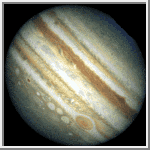 Jupiter
Jupiter
This image was taken by NASA's Hubble Space Telescope on February 13, 1995. The image provides a detailed look at a unique cluster of three white oval-shaped storms that lie southwest (below and to the left) of Jupiter's Great Red Spot. The appearance of the clouds, in this image, is considerably different from their appearance only seven months earlier. These features are moving closer together as the Great Red Spot is carried westward by the prevailing winds while the white ovals are swept eastward.
The outer two of the white storms formed in the late 1930s. In the centers of these cloud systems the air is rising, carrying fresh ammonia gas upward. New, white ice crystals form when the upwelling gas freezes as it reaches the chilly cloud top level where temperatures are -130°C (-200°F). The intervening white storm center, the ropy structure to the left of the ovals, and the small brown spot have formed in low pressure cells. The white clouds sit above locations where gas is descending to lower, warmer regions.
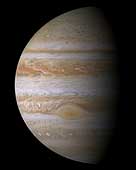 Cassini Jupiter Portrait
Cassini Jupiter Portrait
This true color mosaic of Jupiter was constructed from images taken by the Cassini spacecraft on December 29, 2000, during its closest approach to the giant planet at a distance of approximately 10 million kilometers (6.2 million miles).
It is the most detailed global color portrait of Jupiter ever produced; the smallest visible features are approximately 60 kilometers (37 miles) across. The mosaic is composed of 27 images: nine images were required to cover the entire planet in a tic-tac-toe pattern, and each of those locations was imaged in red, green, and blue to provide true color. Although Cassini's camera can see more colors than humans can, Jupiter's colors in this new view look very close to the way the human eye would see them.
Everything visible on the planet is a cloud. The parallel reddish-brown and white bands, the white ovals, and the large Great Red Spot persist over many years despite the intense turbulence visible in the atmosphere. The most energetic features are the small, bright clouds to the left of the Great Red Spot and in similar locations in the northern half of the planet. These clouds grow and disappear over a few days and generate lightning. Streaks form as clouds are sheared apart by Jupiter's intense jet streams that run parallel to the colored bands. The prominent dark band in the northern half of the planet is the location of Jupiter's fastest jet stream, with eastward winds of 480 kilometers (300 miles) per hour. Jupiter's diameter is eleven times that of Earth, so the smallest storms on this mosaic are comparable in size to the largest hurricanes on Earth.
Unlike Earth, where only water condenses to form clouds, Jupiter's clouds are made of ammonia, hydrogen sulfide, and water. The updrafts and downdrafts bring different mixtures of these substances up from below, leading to clouds at different heights. The brown and orange colors may be due to trace chemicals dredged up from deeper levels of the atmosphere, or they may be byproducts of chemical reactions driven by ultraviolet light from the Sun. Bluish areas, such as the small features just north and south of the equator, are areas of reduced cloud cover, where one can see deeper. (Courtesy NASA/JPL/Space Science Institute)
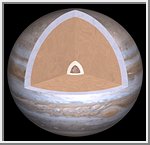 The Interior of Jupiter
The Interior of Jupiter
This picture illustrates the internal structure of Jupiter. The outer layer is primarily composed of molecular hydrogen. At greater depths the hydrogen starts resembling a liquid. At 10,000 kilometers below Jupiter's cloud top liquid hydrogen reaches a pressure of 1,000,000 bar with a temperature of 6,000° K. At this state hydrogen changes into a phase of liquid metallic hydrogen. In this state, the hydrogen atoms break down yeilding ionized protons and electrons similar to the Sun's interior. Below this is a layer dominated by ice where "ice" denotes a soupy liquid mixture of water, methane, and ammonia under high temperatures and pressures. Finally at the center is a rocky or rocky-ice core of up to 10 Earth masses. (Copyright Calvin J. Hamilton)
 Thin Crescent Image of Jupiter
Thin Crescent Image of Jupiter
This thin crescent picture of Jupiter was created from a photomosaic of images Galileo took on its C9 orbit. It is made from Near Infrared and Violet images, with an artificial green image produced from the other two. (Courtesy of Ted Stryk)
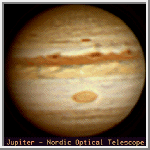 Nordic Optical Telescope
Nordic Optical Telescope
This image of Jupiter was taken with the 2.6 meter Nordic Optical Telescope, located at La Palma, Canary Islands. It is a good example of the best imagery that can be obtained from earth based telescopes. (c) Nordic Optical Telescope Scientific Association (NOTSA).
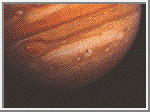 Jupiter with Satellites Io and Europa
Jupiter with Satellites Io and Europa
Voyager 1 took this photo of Jupiter and two of its satellites (Io, left, and Europa, right) on Feb. 13, 1979. In this view, Io is about 350,000 kilometers (220,000 miles) above Jupiter's Great Red Spot, while Europa is about 600,000 kilometers (373,000 miles) above Jupiter's clouds. Jupiter is about 20 million kilometers (12.4 million miles) from the spacecraft at the time of this photo. There is evidence of circular motion in Jupiter's atmosphere. While the dominant large scale motions are west-to-east, small scale movement includes eddy like circulation within and between the bands. (Courtesy NASA/JPL)
 Satellite Footprints Seen in Jupiter Aurora
Satellite Footprints Seen in Jupiter Aurora
In this Hubble Space Telescope picture, a curtain of glowing gas is wrapped around Jupiter's north pole like a lasso. This curtain of light, called an aurora, is produced when high-energy electrons race along the planet's magnetic field and into the upper atmosphere where they excite atmospheric gases, causing them to glow. The aurora resembles the same phenomenon that crowns Earth's polar regions. But this Hubble image, taken in ultraviolet light, also shows the glowing "footprints" of three of Jupiter's largest moons: Io, Ganymede, and Europa.
Courtesy of NASA/ESA, John Clarke (University of Michigan)
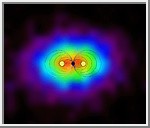 Jupiter's Magnetosphere
Jupiter's Magnetosphere
This image taken by the ion and neutral mass spectrometer instrument on NASA's Cassini spacecraft makes the huge magnetosphere surrounding Jupiter visible in a way no instrument on any previous spacecraft has been able to do. The magnetosphere is a bubble of charged particles trapped within the magnetic environment of the planet. A magnetic field is sketched over the image to place the energetic neutral atom emissions in perspective. This sketch extends in the horizontal plane to a width 30 times the radius of Jupiter. Also shown for scale and location are the disk of Jupiter (black circle) and the approximate position (yellow circles) of the doughnut-shaped torus created from material spewed out by volcanoes on Io.
Some of the fast-moving ions within the magnetosphere pick up electrons to become neutral atoms, and once they become neutral, they can escape Jupiter's magnetic field, flying out from the magnetosphere at speeds of thousands of kilometers, or miles, per second.
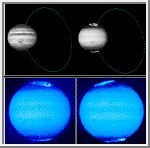 Jupiter's Auroras
Jupiter's Auroras
These HST images, reveal changes in Jupiter's auroral emissions and how small auroral spots just outside the emission rings are linked to the planet's volcanic moon, Io. The top panel pinpoints the effects of emissions from Io. The image on the left, shows how Io and Jupiter are linked by an invisible electrical current of charged particles called a flux tube. The particles, ejected from Io by volcanic eruptions, flow along Jupiter's magnetic field lines, which thread through Io, to the planet's north and south magnetic poles.
The top-right image shows Jupiter's auroral emissions at the north and south poles. Just outside these emissions are the auroral spots called "footprints." The spots are created when the particles in Io's "flux tube" reach Jupiter's upper atmosphere and interact with hydrogen gas, making it fluoresce.
The two ultraviolet images at the bottom of the picture show how the auroral emissions change in brightness and structure as Jupiter rotates. These false-color images also reveal how the magnetic field is offset from Jupiter's spin axis by 10 to 15 degrees. In the right image, the north auroral emission is rising over the left limb; the south auroral oval is beginning to set. The image on the left, obtained on a different date, shows a full view of the north aurora, with a strong emission inside the main auroral oval.
Credits: John T. Clarke and Gilda E. Ballester (University of Michigan), John Trauger and Robin Evans (Jet Propulsion Laboratory), and NASA.
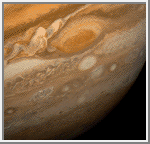 The Great Red Spot
The Great Red Spot
This dramatic view of Jupiter's Great Red Spot and its surroundings was obtained by Voyager 1 on Feb. 25, 1979, when the spacecraft was 9.2 million kilometers (5.7 million miles) from Jupiter. Cloud details as small as 160 kilometers (100 miles) across can be seen here. The colorful, wavy cloud pattern to the left of the Red Spot is a region of extraordinarily complex and variable wave motion. (Courtesy NASA)
 False Color of Jupiter's Great Red Spot
False Color of Jupiter's Great Red Spot
This image is a false color representation of Jupiter's Great Red Spot taken with Galileo's imaging system through three different near-infrared filters. This is a mosaic of eighteen images (6 in each filter) that were taken over a period of 6 minutes on June 26, 1996. The Great Red Spot appears pink and the surrounding region blue because of the particular color coding used in this representation. The red channel is the reflectance of Jupiter at a wavelength where methane strongly absorbs (889nm). Because of this absorption, only high clouds can reflect sunlight in this wavelength. The green channel is the reflectance in a wavelength where methane absorbs, but less strongly (727nm). Lower clouds can reflect sunlight in this wavelength. Finally, the blue channel is the reflectance in a wavelength where there are essentially no absorbers in the Jovian atmosphere (756nm) and one sees light reflected from the deepest clouds. Thus, the color of a cloud in this image indicates its height, with red or white being highest and blue or black being lowest. This image shows the Great Red Spot to be relatively high, as are some smaller clouds to the northeast and northwest that are surprisingly like towering thunderstorms found on earth. The deepest clouds are in the collar surrounding the Great Red Spot, and also just to the northwest of the high (bright) cloud in the northwest corner of the image. Preliminary modelling shows these cloud heights to range about 50km in altitude. (Courtesy NASA/JPL)
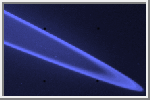 Ring of Jupiter
Ring of Jupiter
The ring of Jupiter was discovered by Voyager 1 in March of 1979. This image was taken by Voyager 2 and has been pseudo colored. The Jovian ring is about 6,500 kilometers (4,000 miles) wide and probably less than 10 kilometers (6.2 miles) thick. (Copyright Calvin J. Hamilton)
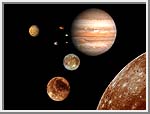 The Jovian System
The Jovian System
The best of the Jupiter system is pictured in this collage of images acquired by the Voyager and Galileo spacecraft. Jupiter is the largest planet in our solar system. The four largest moons of Jupiter are known as the Galilean moons and are named Callisto, Ganymede, Europa, and Io. Inside the orbits of the Galilean moons are Thebe, Amalthea, Adrastea, and Metis. At the lower right is shown the Valhalla region of Callisto. Ganymede is toward the bottom middle. Europa is a little above and to the right of Ganymede. Io is the top, left-most moon. Between Io and Jupiter are four little moons. The top-most little moon is Amalthea. Below and to the right of Amalthea are Metis and Adrastea. To the left of Adrastea is Thebe. (Copyright Calvin J. Hamilton)
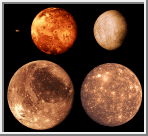 Moons of Jupiter
Moons of Jupiter
This image shows to scale Jupiter's moons Amalthea, Io, Europa, Ganymede, and Callisto. (Copyright Calvin J. Hamilton)
| Name | Distance* | Width | Thickness | Mass | Albedo |
|---|---|---|---|---|---|
| Halo | 92,000 km | 30,500 km | 20,000 km | ? | 0.05 |
| Main | 122,500 km | 6,440 km | <> | 1 x 10^13 kg | 0.05 |
| Inner Gossamer | 128,940 km | 52,060 km | ? | ? | 0.05 |
| Outer Gossamer | 181,000 km | 40,000 km | ? | ? | 0.05 |
*The distance is measured from the planet center to the start of the ring.
Nearly four centuries ago Galileo Galilei turned his homemade telescope towards the heavens and discovered three points of light, which at first he thought to be stars, hugging the planet Jupiter. These stars were arranged in a straight line with Jupiter. Sparking his interest, Galileo observed the stars and found that they moved the wrong way. Four days later another star appeared. After observing the stars over the next few weeks, Galileo concluded that they were not stars but planetary bodies in orbit around Jupiter. These four stars have come to be know as the Galilean satellites.
Over the course of the following centuries another 12 moons were discovered bringing the total to 16. Another 12 satellites have been recently discovered and given provisional designators until they are officially confirmed and named. Finally in 1979, the strangeness of these frozen new worlds was brought to light by the Voyager spacecrafts as they swept past the Jovian system. Again in 1996, the exploration of these worlds took a large step forward as the Galileo spacecraft began its long term mission of observing Jupiter and its moons.
Twelve of Jupiter's moons are relatively small and seem to have been more likely captured than to have been formed in orbit around Jupiter. The four large Galilean moons, Io, Europa, Ganymede and Callisto, are believed to have accreted as part of the process by which Jupiter itself formed. The following table summarizes the radius, mass, distance from the planet center, discoverer and the date of discovery of each of the moons of Jupiter:
| Moon | # | Radius (km) | Mass (kg) | Distance (km) | Discoverer | Date |
|---|---|---|---|---|---|---|
| Metis | XVI | 20 | 9.56e+16 | 127,969 | S. Synnott | 1979 |
| Adrastea | XV | 12.5x10x7.5 | 1.91e+16 | 128,971 | Jewitt-Danielson | 1979 |
| Amalthea | V | 135x84x75 | 7.17e+18 | 181,300 | E. Barnard | 1892 |
| Thebe | XIV | 55x45 | 7.77e+17 | 221,895 | S. Synnott | 1979 |
| Io | I | 1,815 | 8.94e+22 | 421,600 | Marius-Galileo | 1610 |
| Europa | II | 1,569 | 4.80e+22 | 670,900 | Marius-Galileo | 1610 |
| Ganymede | III | 2,631 | 1.48e+23 | 1,070,000 | Marius-Galileo | 1610 |
| Callisto | IV | 2,400 | 1.08e+23 | 1,883,000 | Marius-Galileo | 1610 |
| S/1975 J1 S/2000 J1 | 4 | ? | 7,435,000 | Sheppard et al | 2000 | |
| Leda | XIII | 8 | 5.68e+15 | 11,094,000 | C. Kowal | 1974 |
| Himalia | VI | 93 | 9.56e+18 | 11,480,000 | C. Perrine | 1904 |
| Lysithea | X | 18 | 7.77e+16 | 11,720,000 | S. Nicholson | 1938 |
| Elara | VII | 38 | 7.77e+17 | 11,737,000 | C. Perrine | 1905 |
| S/2000 J11 | 2 | ? | 12,654,000 | Sheppard et al | 2000 | |
| S/2000 J10 | 1.9 | ? | 20,375,000 | Sheppard et al | 2000 | |
| S/2000 J3 | 2.6 | ? | 20.733,000 | Sheppard et al | 2000 | |
| S/2000 J5 | 2.2 | ? | 21,019,000 | Sheppard et al | 2000 | |
| S/2000 J7 | 3.4 | ? | 21,162,000 | Sheppard et al | 2000 | |
| Ananke | XII | 15 | 3.82e+16 | 21,200,000 | S. Nicholson | 1951 |
| S/2000 J9 | 2.5 | ? | 21,734,000 | Sheppard et al | 2000 | |
| S/2000 J4 | 1.6 | ? | 21,948,000 | Sheppard et al | 2000 | |
| Carme | XI | 20 | 9.56e+16 | 22,600,000 | S. Nicholson | 1938 |
| S/2000 J6 | 1.9 | ? | 22,806,000 | Sheppard et al | 2000 | |
| Pasiphae | VIII | 25 | 1.91e+17 | 23,500,000 | P. Melotte | 1908 |
| S/2000 J8 | 2.7 | ? | 23,521,000 | Sheppard et al | 2000 | |
| Sinope | IX | 18 | 7.77e+16 | 23,700,000 | S. Nicholson | 1914 |
| S/2000 J2 | 2.6 | ? | 24,164,000 | Sheppard et al | 2000 | |
| S/1999 J1 1999 UX18 | 2.4 | ? | 24,296,,000 | Spacewatch | 1999 |

 Return to Mars
Return to Mars  Voyage to Saturn
Voyage to Saturn
Resource: www.solarviews.com/eng/jupiter.htm
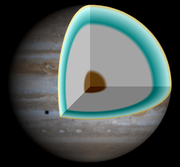



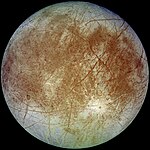

Tidak ada komentar:
Posting Komentar